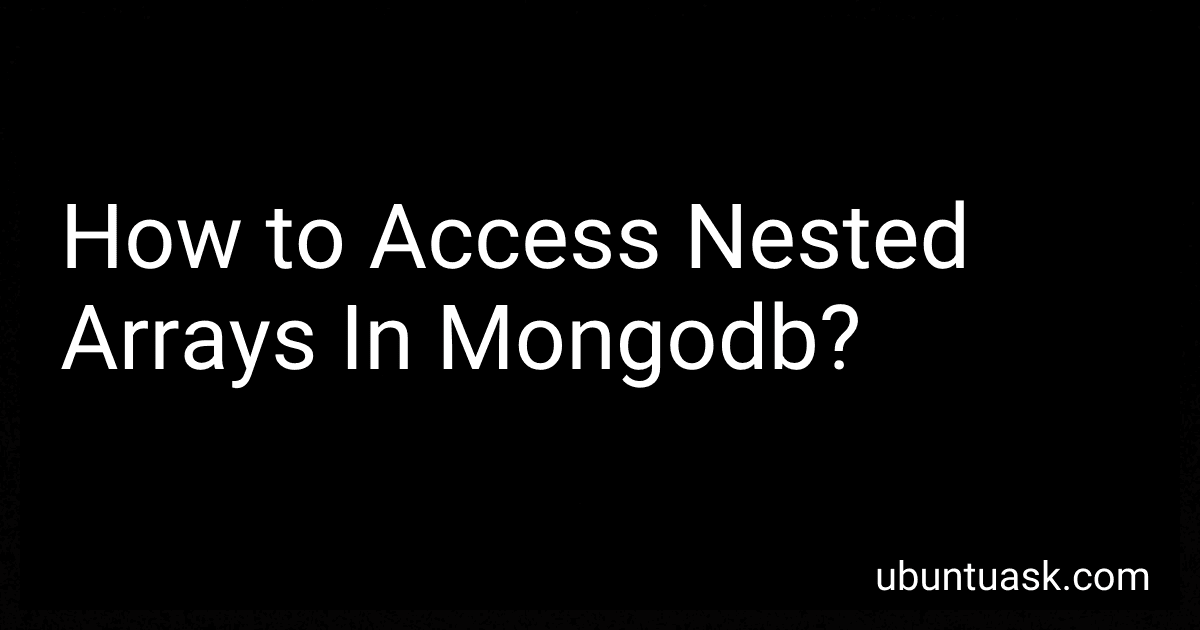Best MongoDB Resources to Buy in December 2025

MongoDB: The Definitive Guide: Powerful and Scalable Data Storage



Mastering MongoDB 7.0: Achieve data excellence by unlocking the full potential of MongoDB



Practical MongoDB Aggregations: The official guide to developing optimal aggregation pipelines with MongoDB 7.0



MongoDB: The Definitive Guide: Powerful and Scalable Data Storage



MongoDB Essentials: Build Faster, Perform Better, Store Smarter, Scale Bigger, and Master Document Database



MongoDB in Action, Third Edition: Building on the Atlas Data Platform



MongoDB Data Modeling and Schema Design



Modern Full-Stack React Projects: Build, maintain, and deploy modern web apps using MongoDB, Express, React, and Node.js


To access nested arrays in MongoDB, you can use dot notation to navigate through the objects within the arrays. For example, if you have a document with a nested array structure like this:
{ "_id": "1", "name": "John", "orders": [ { "order_id": "1", "products": ["apple", "banana", "orange"] }, { "order_id": "2", "products": ["grapes", "kiwi"] } ] }
You can access the products array within the first order by using the following query:
db.collection.find({ "orders.order_id": "1" }, { "orders.$.products": 1 })
This query will return the products array for the first order in the document. You can also use the $elemMatch operator to retrieve specific elements from the nested array based on certain conditions.
How to create indexes on nested arrays in MongoDB?
To create an index on nested arrays in MongoDB, you can use dot notation to specify the field within the nested array that you want to create an index on. Here's an example:
Let's say you have a collection called "users" with documents that look like this:
{ "_id": 1, "name": "John Doe", "emails": [ { "type": "work", "address": "john.doe@example.com" }, { "type": "personal", "address": "johndoe@gmail.com" } ] }
If you want to create an index on the "address" field within the "emails" array, you can do so like this:
db.users.createIndex({"emails.address": 1});
This will create a single-field index on the "address" field within the "emails" array.
You can also create compound indexes on nested arrays by including multiple fields in the index definition:
db.users.createIndex({"emails.type": 1, "emails.address": 1});
This will create a compound index on the "type" and "address" fields within the "emails" array.
After creating the index, you can use it in queries to improve performance. Just remember to use dot notation to access the nested fields in your queries.
What is the role of projection in accessing nested arrays in MongoDB?
In MongoDB, projection allows users to specify which fields in a document they want to retrieve or exclude from the query result. When working with nested arrays in MongoDB, projection can be used to access and retrieve specific elements within the nested array.
By using the dot notation in the projection field, users can specify the path to the nested array element they want to retrieve. For example, if a document has a nested array called "comments" and each comment has a field called "text", users can retrieve a specific comment's text field by using the projection field like this: { "comments.text": 1 }.
Projection can also be used to exclude certain nested array elements from the query result by setting the field to 0. For example, if users want to retrieve all fields from a document except for the "personalDetails" array, they can use projection like this: { "personalDetails": 0 }.
Overall, projection plays a crucial role in accessing nested arrays in MongoDB by allowing users to selectively retrieve or exclude specific elements within the nested array.
How to update nested arrays in MongoDB?
To update nested arrays in MongoDB, you can use the $ operator in combination with the $push, $addToSet, $pull, or $each operator. Here's an example of how you can update a nested array in MongoDB:
Suppose you have a collection called "users" with documents structured like this:
{ "_id": 1, "name": "John", "favorites": { "movies": ["The Matrix", "Inception"], "foods": ["Pizza", "Sushi"] } }
To update the "movies" array in the "favorites" field for the user with _id 1, you can use the $push operator like this:
db.users.update( { "_id": 1 }, { $push: { "favorites.movies": "Interstellar" } } )
This will add "Interstellar" to the "movies" array, and the document will be updated to:
{ "_id": 1, "name": "John", "favorites": { "movies": ["The Matrix", "Inception", "Interstellar"], "foods": ["Pizza", "Sushi"] } }
Similarly, you can use the $addToSet operator to add unique elements to the array, the $pull operator to remove elements from the array, and the $each operator to add multiple elements to the array at once.
Keep in mind that the $ operator identifies an element in an array to update without specifying the position of the element.
